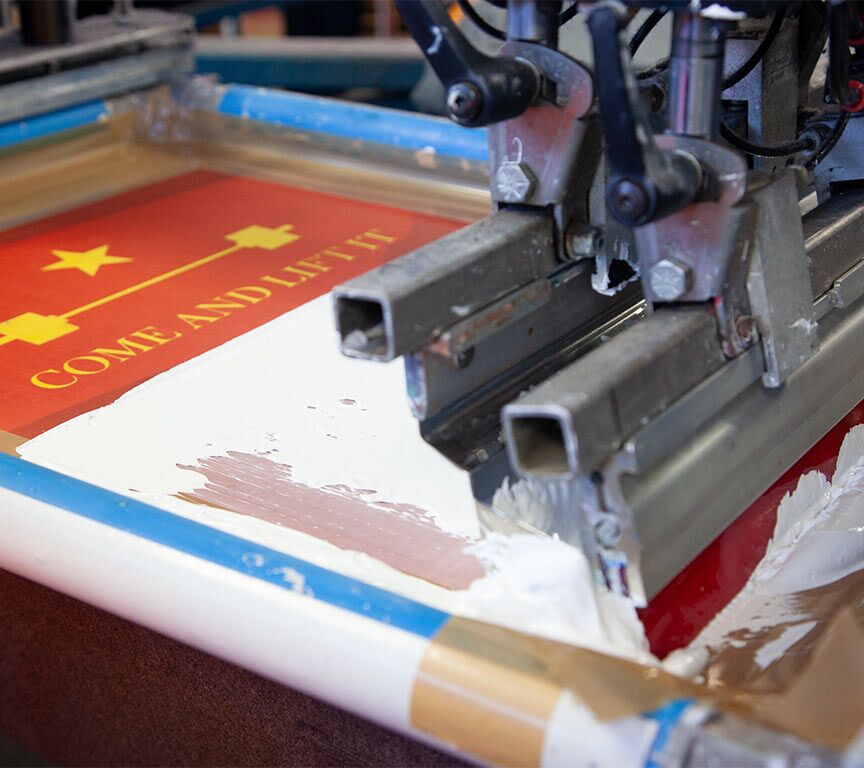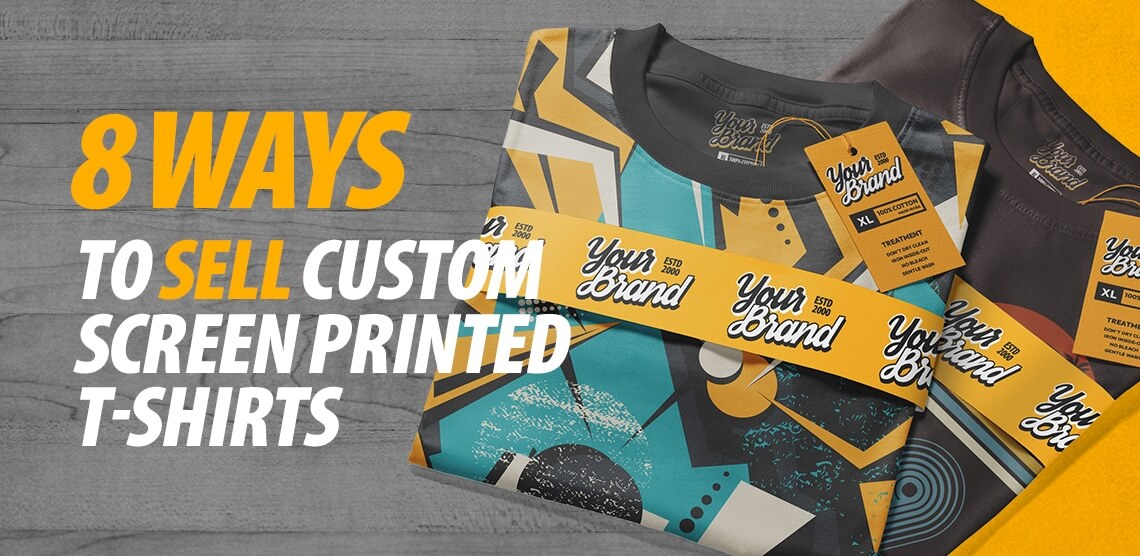Fast Turnaround Custom Screen Printing for Events
Fast Turnaround Custom Screen Printing for Events
Blog Article
Display Printing Uncovered: Everything You Required to Understand About Tee and Garment Printing Strategies
If you have actually ever questioned how those vivid layouts wind up on your favorite t-shirts, you're in the best area. Screen printing is an interesting technique that incorporates art with strategy, supplying countless opportunities for creative thinking. Recognizing the principles, from tools to ink selections, can greatly affect your outcomes. All set to explore the essential components that make screen printing an art form? Let's discover the information that can elevate your projects.
The Fundamentals of Screen Printing: Just How It Functions
When you dive into screen printing, you'll find it's both a science and an art. At its core, display printing involves creating a stencil, or screen, that enables ink to pass via only in details locations (screen printing kit). You begin by picking your layout and preparing your screen with a light-sensitive solution. When you expose this solution to light, it solidifies, leaving your layout as an unfavorable space.
Following, you'll blend your inks and prepare your printing surface. Position the screen over the textile, after that make use of a squeegee to push ink via the screen onto the garment. This procedure needs accuracy, as you want clear, lively prints. After printing, you'll treat the ink with warmth, guaranteeing it abides by the fabric and lasts through cleans. Each step is necessary, and understanding them will raise your display printing skills, changing easy garments right into unique, meaningful items.
Kinds Of Screen Printing Methods
When you comprehend the basics of screen printing, it's time to explore the different techniques that can raise your designs. One prominent approach is conventional screen printing, where ink is pressed with a stenciled screen.
An additional alternative is plastisol printing, understood for its toughness and vibrant colors, making it a preferred for numerous brand names. Experiment with halftone printing to produce gradient impacts and intricate layouts.
Necessary Devices for Display Printing
To attain sensational outcomes in display printing, having the appropriate tools is essential. You'll need a strong display printing framework, which holds the mesh that transfers your style onto the garment. Next, invest in high-quality squeegees; these are essential for applying ink evenly across the screen.
Choosing the Right Inks and Materials
When choosing inks and products for display printing, you require to take right into account the kind of ink that functions finest for your job. Believe concerning textile compatibility to assure your designs look last and wonderful lengthy. Likewise, check out eco-friendly ink options to make your printing process more sustainable.
Sorts Of Screen Inks
Picking the ideal display ink is necessary for achieving vivid, resilient prints that satisfy your project's requirements. There are numerous types of screen inks to check out. Specialty inks, such as glow-in-the-dark or metallic, can add special results to your designs.

Material Compatibility Factors To Consider
Recognizing fabric compatibility is important for attaining top notch screen prints, specifically given that different products react distinctively to different inks. Constantly evaluate your inks on example fabric to assure they adhere correctly and maintain shade stability. In addition, keep in mind that textile weight and texture can influence the final end result, so choosing the right ink and product combo is vital for your task's success.
Eco-Friendly Ink Options
Environment-friendly inks are coming to be a popular option for screen printers who desire to lessen their ecological influence while maintaining high quality. When choosing inks, take into consideration water-based inks, which are much less hazardous and much easier to cleanse up contrasted to conventional solvents.
Furthermore, seek inks made from renewable energies, such as soy or vegetable-based choices. By selecting the ideal inks and materials, you'll not only create sensational styles however likewise add to a much more sustainable printing process. Make the button, and your prints will show your dedication to the atmosphere!
Preparing Your Layout for Screen Printing

File Format Demands
To assure your design looks sharp and vibrant on fabric, you'll require to pay close attention to submit format demands for screen printing. Beginning with vector files like AI or EPS, as they can be scaled without shedding top quality. If you utilize raster photos, select high-resolution documents, such as TIFF or PNG, ideally at 300 DPI. Prevent making use of JPEGs, as they can lose clearness when resized. Likewise, see to it your style has a clear background to avoid unwanted white edges on your prints. Finally, keep color settings in mind; CMYK is common for display printing, so convert your RGB creates accordingly. By adhering to these guidelines, you'll set your artwork up for a successful print.
Color Splitting Up Techniques
Color splitting up is an essential step in preparing your design for display printing, and understanding it can greatly enhance your print quality. You'll need to damage your layout right into specific shades, as each color needs a different display throughout printing. Beginning by determining all the shades in your style and produce layers for each one. You can utilize software application like Adobe Photoshop or Illustrator to isolate and different shades efficiently. Be specific to conserve each layer as a different data, normally in a style like TIFF or PSD. This precision not only assures exact color representation but also simplifies the printing procedure. By focusing on shade splitting up, you'll achieve lively and specialist outcomes in your screen-printed garments.
Resolution and Size
Achieving the ideal lead to display printing starts with guaranteeing your layout has the ideal resolution and size. Preferably, your art work ought to be at the very least 300 DPI (dots per inch) for sharp, clear prints. If you use reduced resolution, your end product could look pixelated and unprofessional.
When it pertains to dimension, think about the measurements of your print location. Style your art work to match the final print dimension, preferably developing it in the actual dimensions you'll be publishing. This way, you'll prevent any kind of unforeseen scaling issues.
Always examine your style in both vector and raster formats. Vector graphics can be scaled without losing quality, making them excellent for screen printing. Preparing correctly will guarantee your layout looks amazing on every garment!
Step-by-Step Display Printing Process
Display printing is a dynamic procedure that enables you to create vibrant layouts on various surface areas. To get started, you'll need a display, emulsion, and your selected ink. Prepare your screen by look at here cleaning it thoroughly. Next off, use the emulsion evenly and let it completely dry in a dark area. When dry, reveal your screen to light with your layout positioned on it, which will solidify the solution where the light hits, developing a pattern - screen printing kit.
After rinsing the unexposed emulsion, your screen is ready. Set it up on your printing surface area and straighten your garment under it. Put ink onto the display and make use of a squeegee to press the ink with the pattern onto the material. Lift the screen carefully and let the print completely dry. Ultimately, heal the ink making use of warmth to ensure sturdiness. That's it! You have actually efficiently display printed your design.
Tips for Effective Screen Printing Projects
While you're diving right into your screen printing projects, bear in mind that preparation is essential to success. Beginning by collecting all your materials-- inks, mops, displays, and garments. A clean work area helps prevent unwanted mistakes, so clean prior to you begin.
Following, verify your art work read review is high-resolution and appropriately sized for your garment. Check your screen for appropriate exposure and tidy it thoroughly to prevent spots. When mixing your inks, comply with the manufacturer's guidelines to achieve the ideal consistency.
Throughout printing, use even pressure with your squeegee for regular results. Do not hurry; take your time to verify each print fulfills your standards. After printing, allow your garments dry totally prior to dealing with or packaging them.
Lastly, always keep a sample of your help future reference. This way, you can evaluate your progress and enhance your strategies over time. Pleased printing!

Often Asked Concerns
Exactly how Lengthy Does It Take to Establish a Screen Printing Task?
Establishing a screen printing job normally takes around half an hour to an hour. You'll prepare the screens, mix inks, and adjust the press. The time varies based upon intricacy and experience, so remain arranged!
Can I Publish on Various Material Enters Using the Same Technique?
Yes, you can print on various textile kinds making use of the same strategy, yet you'll require to readjust your setups and inks. Some textiles soak up ink differently, so trying out guarantees the most effective results for each material.
What Prevail Blunders to Prevent in Display Printing?
When display printing, avoid common blunders like using the wrong ink, ignoring correct exposure times, or missing pre-press checks. Always check your arrangement and preserve tidy screens to assure high quality results each time.
Just How Can I Properly Tidy and Keep My Display Printing Tools?
To correctly tidy and preserve your screen printing tools, you must regularly clean screens with appropriate solvents, check mops for wear, and assure all tools are stored completely dry and dust-free. Uniformity prevents pricey fixings and enhances performance.
Is Display Printing Eco-friendly Compared to Other Techniques?
Display printing Read Full Article can be much more eco-friendly than other approaches, especially if you utilize water-based inks and eco-conscious products. By picking sustainable products and practices, you lower waste and lessen your effect on the planet.
Display Printing Uncovered: Whatever You Need to Know Concerning Tee and Garment Printing Methods
At its core, screen printing involves creating a pattern, or display, that permits ink to pass via only in certain locations. Placement the screen over the fabric, after that make use of a squeegee to push ink with the display onto the garment. One preferred method is standard display printing, where ink is pressed via a stenciled screen.When selecting inks and products for screen printing, you need to take right into account the kind of ink that works finest for your task.
Report this page